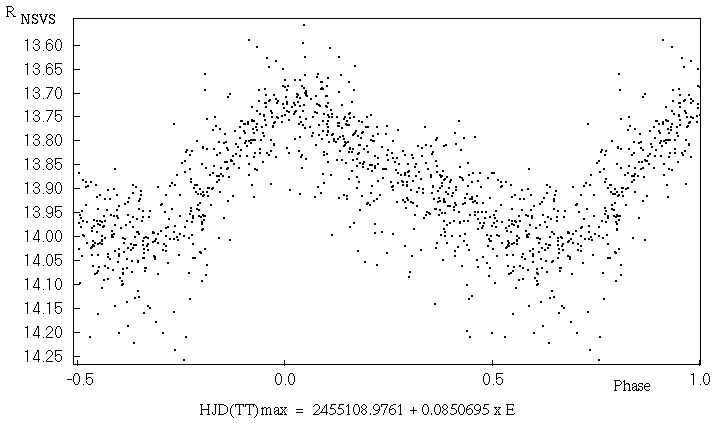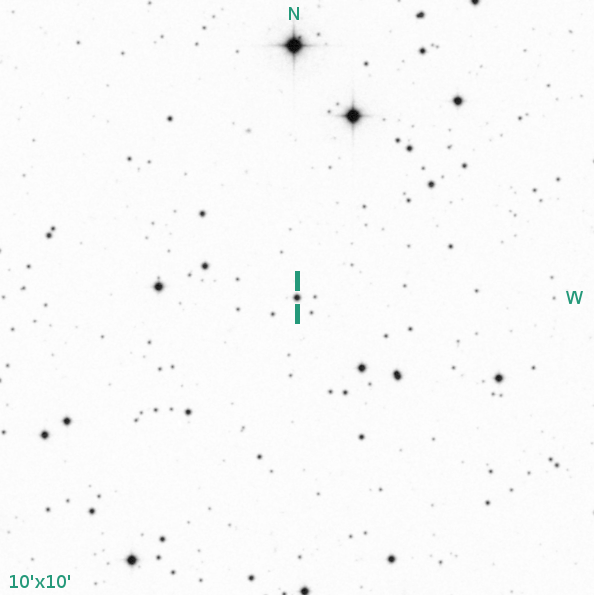| Article in PDF |
"Peremennye Zvezdy", Prilozhenie, vol. 9, N 30 (2009) |
NSVS 304708 is a High Amplitude Delta Scuti Star
K. V. Sokolovsky
Max Planck Institute for Radio Astronomy, Bonn, Germany; and
Astro Space Center of Lebedev Physical Institute, Moscow, Russia
| ISSN 2221–0474 |
Received: 12.10.2009; accepted: 5.11.2009
(E-mail for contact: ksokolov@mpifr-bonn.mpg.de)
| ||||||||||||||||||||||
Remarks: |
| NSVS 304708 was identified as a W UMa type eclipsing binary with the period of
only 0.17014 days by J. Scott Shaw and collaborators in their online
list (http://hal.physast.uga.edu/~jss/nsvs/) of periodic variable stars found in
the Northern
Sky Variability Survey (NSVS, Wozniak et al. 2004, see also http://skydot.lanl.gov/nsvs).
If confirmed, it would be a unique
object since its suggested period is much shorter than the sharp period cut-off
at
0.215 - 0.22 days observed for W UMa type systems (see e.g. Rucinski 2006).
I have obtained 284 photometric measurements of the star between September 15 and October 8, 2009 using a remotely controlled Takahashi FSQ 106 telescope (D = 106 mm, F = 530 mm) of the Tzec Maun observatory near Mayhill, New Mexico, USA. An unfiltered SBIG STL-11000M CCD camera was used. Basic image reduction and photometry were performed with the VaST software (Sokolovsky & Lebedev 2005; more up-to-date information about the program can be found at the VaST homepage, http://scan.sai.msu.ru/vast/). I have also reanalyzed the archival NSVS data. Three objects in the database correspond to the variable star: NSVS 304708, 249240 and 1437339. After removing a few obvious outliers from the lightcurve, I was left with 621 NSVS measurements. After adjusting zero points of FSQ 106 and two NSVS lightcurves (249240 and 1437339) to match the zero point of the third NSVS lightcurve (304708), the period search was performed using the Discrete Fourier Transform (DFT) method implemented in the Period04 software developed by Lenz & Breger (2005) (Period04 homepage http://www.univie.ac.at/tops/Period04/). One dominant frequency of 11.755094 +/-0.0003 c/d (corresponding to the period 0.0850695 +/-0.000002 d) with the half-amplitude 0.125 +/-0.004 mag. was detected in the power spectrum. The period and shape of the phased lightcurve allow us to unambiguously identify the variable as a High Amplitude Delta Scuti pulsating star (HADS), therefore ruling out its classification as a W UMa eclipsing binary. The ten-year baseline between the archival and modern observations allows us to determine the pulsation period with high accuracy, assuming it remained constant during that time. Due to the sparse time sampling, the power spectrum consists of a series of closely separated peaks. To estimate the period uncertainty presented above, the distance between two almost equally significant spectral peaks was used instead of width of the most significant peak, which would lead to (formally) ~100 times smaller uncertainty. Acknowledgments The author is grateful to the Tzec Maun Foundation and Leonid Elenin ("Astrogalaxy" team leader) for making these observations possible and to Dr. V.P. Goranskij for providing his lightcurve analysis software. This work has made use of the Aladin interactive sky atlas, operated at CDS, Strasbourg, France and the International Variable Star Index (VSX) operated by the AAVSO. The author was supported by the International Max Planck Research School (IMPRS) for Astronomy and Astrophysics at the universities of Bonn and Cologne. |
| References: |
| Lenz, P., Breger, M., 2005, Comm. in Asteroseismology, 146, 53
Rucinski, S.M., 2006, MNRAS, 368, 1319 Sokolovsky, K., Lebedev, A., 2005, in 12th Young Scientists' Conference on Astronomy and Space Physics, Kyiv, Ukraine, April 19-23, 2005, eds.: Simon, A.; Golovin, A., p.79 Wozniak, P.R., Vestrand, W.T., Akerlof, C.W., et al., 2004, Astron. J., 127, 2436 |
Light Curve
Phased lightcurve of NSVS 304708 obtained by combining the FSQ 106 unfiltered photometry with the archival NSVS data. Finding Chart 
DSS2 Red image centered on NSVS 304708. Data Source |